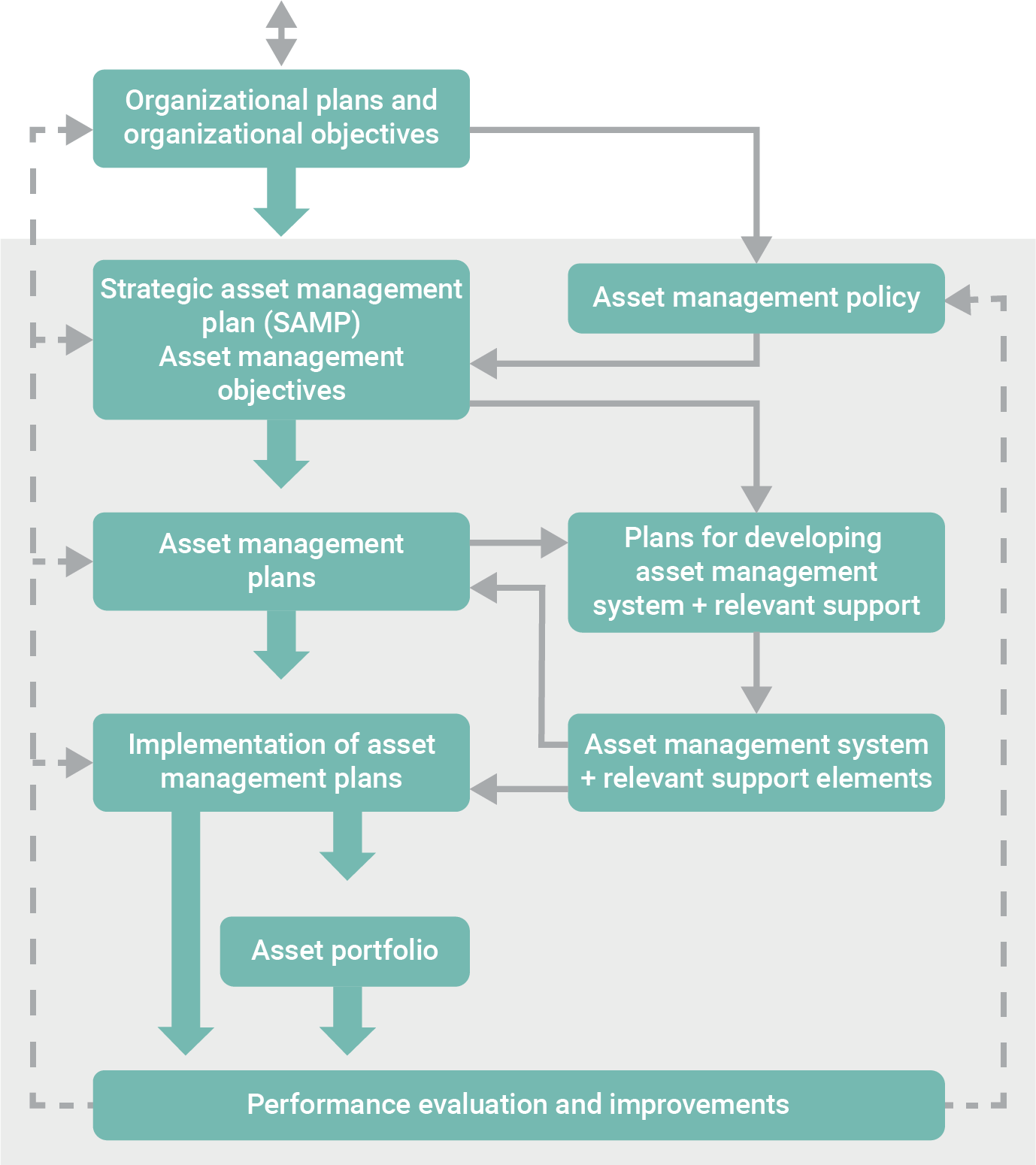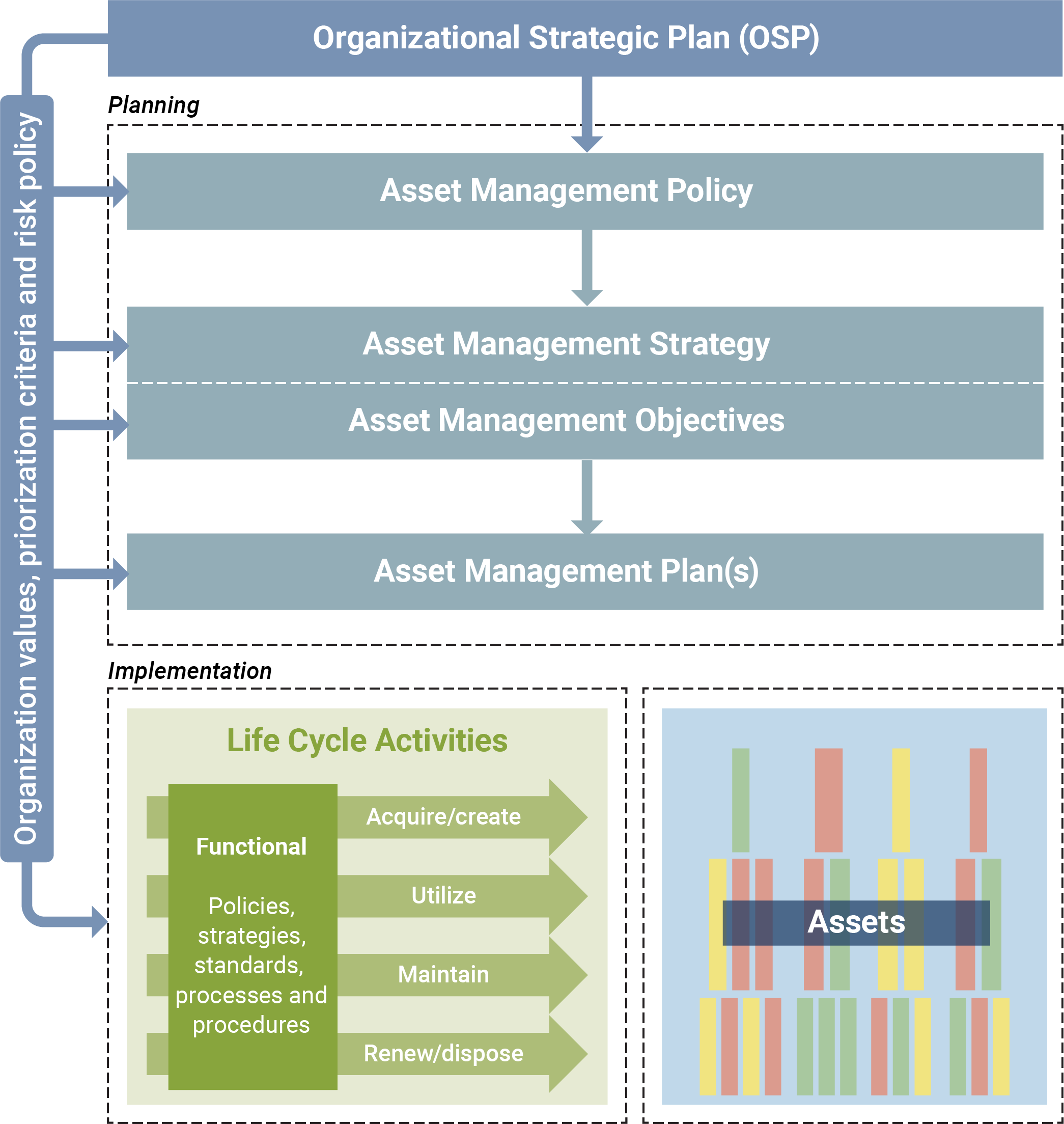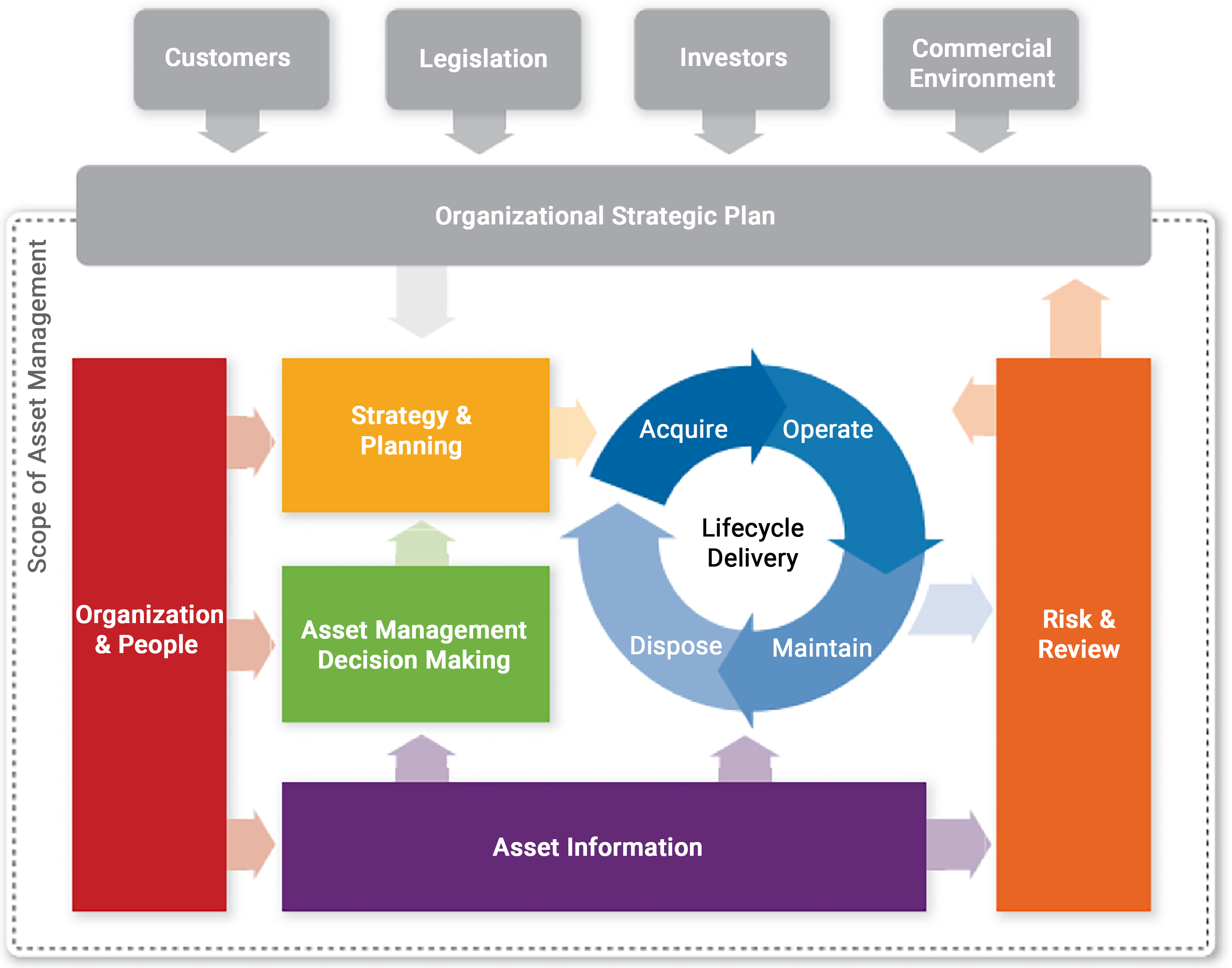- Chapters
-
Chapter 1
Sections - Chapter 1 Home Page
- Chapter PDF
Chapter 1
Quick Links
Section 1.3
TAM Resources
TAM Resources
This section provides the information on accessing some of the key references used throughout the guide. Each sub-section briefly describes the reference and notes how to access the document or information.
- Chapters
-
Chapter 1
Sections - Chapter 1 Home Page
- Chapter PDF
Chapter 1
Quick Links
1.3.1
Frameworks and Guidance
There are numerous existing frameworks, models, and guidance documents related to asset management. This Guide is intended to build upon these existing resources and provide updated information where necessary.
International Organization for Standardization (ISO)
ISO has published a set of standards on asset management. Standard 55000 provides an overview of asset management and asset management systems (i.e. management systems for the management of assets). It also provides the context for ISO 55001 and ISO 55002. International cooperation in the preparation of these standards has identified common practices that can be applied to the broadest range of assets, in the broadest range of organizations, across the broadest range of cultures. The adoption of this International Standard enables an organization to achieve its objectives through the effective and efficient management of its assets. The application of an asset management system provides assurance that those objectives can be achieved consistently and sustainably over time.
Additional standards related to asset management include ISO 55010 which covers guidance on alignment of asset management, finance and accounting; and ISO 55011 which covers guidance on the development of government asset management policy. For more information, the standard is available to purchase: https://www.iso.org/standard/55088.html
Figure 1.3 Relationship between key elements of an asset management program
The gray box designates the boundary of the asset management system
Source: Adapted from ISO 55000. 2016
Publicly Available Standard (PAS) 55
Prior to the development of ISO 55000, the Publicly Available Standard (PAS) 55 was released by the British Standards Institute. This standard contains terms and definitions; information on asset management policy, strategy, and objectives; discussion on implementing asset management plans; as well as performance assessment and improvement information. The standard is available to purchase: https://www.iso.org/obp/ui/#iso:std:iso:55000:ed-1:v2:en.
Figure 1.4 Planning and Implementation Elements of an Asset Management System
Source: Adapted from PAS 55
Institute of Asset Management (IAM)
The IAM publication, Asset Management – An Anatomy (2015), provides a basic overview of asset management and its benefits. It also provides a discussion of six asset management subject areas: Strategy and Planning, Asset Management Decision-Making, Life Cycle Delivery, Asset Information, Organization and People, and Risk and Review. These subject areas are reflected in the framework shown in Figure 1.5.
IAM also has information on developing and maintaining a Strategic Asset Management Plan (SAMP). All of their resources can be found on their website: https://theiam.org/.
Figure 1.5 Planning and implementation elements of an asset management system
Source: Adapted from PAS 55
Institute of Public Work Engineering Australasia (IPWEA)
Institute of Public Work Engineering Australasia (IPWEA) IPWEA has produced the International Infrastructure Management Manual (IIMM). This guide provides checklists, process, guidance, and case studies on asset management practice from agencies globally. The manual contains guidance for all infrastructure types and is suitable for agencies of all levels of maturity. The manual is written to align with ISO 55000 with a focus on how to implement asset management concepts.
The IIMM must be purchased from the IPWEA online bookshop which can be accessed here: https://www.ipwea.org/resourcesnew/bookshop/iimm.
UK Road Liaison Group
The UK Road Liaison Group developed the publication titled Well-Managed Highway Infrastructure: A Code of Practice. This code is designed to support and promote the adoption of an integrated asset management approach to highway infrastructure based on the establishment of levels of service through risk based assessment. The code is broken into four sections: Overarching Principles, Highways, Structures, and Lighting. The Code also summarizes 36 recommendations put forward to the Department for Transport to enhance asset management across UK highway networks.
A PDF of this document is available online: http://www.ukroadsliaisongroup.org/en/utilities/document-summary.cfm?docid=4F93BA10-D3B0-4222-827A8C48401B26AC.
- Chapters
-
Chapter 1
Sections - Chapter 1 Home Page
- Chapter PDF
Chapter 1
Quick Links
1.3.2
Legislation and Regulations
The federal government recognizes the importance of asset management practice and requires states to develop transportation asset management plans. Many state governments also have implemented laws related to asset management.
Federal Legislation
The transportation authorization legislation Moving Ahead for Progress in the 21st Century (MAP-21) signed into law in 2012 includes a number of provisions related to asset management and performance management for both highway and transit modes. The requirements established in MAP-21 were continued in the subsequent legislation Fixing America First Act (FAST) signed into law in 2015. For the highway mode MAP-21 defines asset management in the context of transportation and requires that State DOTs develop risk-based transportation asset management plans (TAMPs) for assets on the National Highway System (NHS). The law also includes a number of requirements related to performance management. Regarding transit MAP-21 requires that U.S. transit agencies develop TAMPs that detail asset conditions and include a prioritized list of state of good repair (SGR) investments.
Following passage of MAP-21 and FAST the Federal Highway Administration (FHWA) and Federal Transit Administration (FTA) developed rules detailing the TAM requirements for highways and transit, respectively. In 2016 FHWA finalized § 23 Code of Federal Regulations (CFR) Part 515 – Asset Management Plans. FHWA’s requirements specify that a TAMP should detail asset inventory, current conditions, and predicted future conditions over a 10-year period, using performance measures detailed in FHWA’s performance management regulations. The TAMP should include the following elements:
- Asset Management Objectives
- Asset Management Measures and Targets
- Inventory and Conditions
- Performance Gap Identification
- Life-Cycle Planning
- Risk Management Analysis
- Financial Plan
- Investment Strategies
In 2016, the FTA finalized asset management requirements U.S. transit agencies must follow. These requirements are detailed in §49 CFR Parts 625 and 630. The FTA requirements detail that transit agencies must prepare TAMPs covering a four-year period and including their revenue vehicles, infrastructure, facilities, and equipment (including service vehicles). Agencies must use a decision support tool to help analyze SGR investment needs and develop a prioritized list of needs. Larger agencies (with rail systems and/or 100 or more vehicles in peak revenue service) must include additional materials in their TAMP, such as a TAM/SGR policy, TAM implementation strategy, evaluation plan, and identification of resources required to implement the plan.
TAM Webinar #52 – The IIJA and TPM
Infrastructure Investment and Jobs Act
The Infrastructure Investment and Jobs Act/Bipartisan Infrastructure Law (IIJA/BIL) that took effect on October 1, 2021 required State DOTs to consider extreme weather and resilience as part of the life-cycle planning and risk management analyses within a State TAMP. This means that state DOTs must take into account the potential for extreme weather events, such as hurricanes, floods, and wildfires, when making decisions about how to maintain and invest in their transportation infrastructure. This change is important because it will better inform the decision-making of State DOTs and other Federal-aid recipients who ultimately select projects in which to invest federal-aid dollars to improve the resilience of the surface transportation network. These updates were first required in 2022 as State DOT updated their TAMP development processes and TAMPs based on the 4-year cycle in Title 23, Code of Federal Regulations (CFR), Part 515.13(c).
The IIJA/BIL also provides funding for a number of new programs that are relevant to transportation asset management, such as the Bridge Investment Program and the National Electric Vehicle Infrastructure Formula Program. These programs can help state DOTs to make necessary repairs and upgrades to their transportation infrastructure, and to invest in new technologies that can make their transportation systems more sustainable and resilient.
In addition, the IIJA/BIL includes a number of provisions that are designed to improve the efficiency and effectiveness of state DOT transportation asset management programs. These provisions include requirements for state DOTs to develop and implement asset management plans, to collect and use data to inform their asset management decisions, and to collaborate with other stakeholders on asset management issues.
TAM Webinar #44 - TAMP and STIP Integration
The most recent information on federal requirements and regulations are available at the following:
FHWA Transportation Asset Management: https://www.fhwa.dot.gov/asset/
FTA Transit Asset Management: https://www.transit.dot.gov/TAM
- Chapters
-
Chapter 1
Sections - Chapter 1 Home Page
- Chapter PDF
Chapter 1
Quick Links
1.3.3
Assessment Tools and Maturity Models
Assessing asset management maturity helps establish goals and encourages improvement. This section provides information on existing assessment tools and maturity models agencies can use as resources.
TAM Gap Analysis Tool
This Excel-based gap analysis tool was developed under National Cooperative Highway Research Program (NCHRP) Project 08-90 and builds on the gap analysis tool introduced in the AASHTO Transportation Asset Management Guide – A Focus on Implementation. The tool helps agencies identify and prioritize needed enhancements to their asset management programs.
In 2023, the TAM Gap Analysis Tool was reproduced as a web-based tool, providing enhanced functionality and a streamlined user experience, resolving software compatibility issues that had developed in the 2014 excel-based version, and updating the assessment framework to better reflect current practices. More information on the TAM Gap Analysis Tool is provided in section 1.4, TAM Gap Analysis Tool Overview. The new version of the tool and the User’s Guide are available on the AASHTO TAM Portal: https://www.tam-portal.com/resource-set/tam-gap-analysis-tool-nchrp-08-90/
TAM Webinar #57 - TAM Tools Miniseries 04: Techniques
IAM Maturity Scale and Guidance
The IAM Maturity Scale and Guidance document provides a generic maturity scale for agencies looking to assess their current asset management practice and determine ways to grow and mature. This guidance is available for purchase here: https://theiam.org/asset-management-maturity-scale-and-guidance-pdf/.
Data Gap Assessment Tool
To assess data and information maturity, agencies can use NCHRP Report 814, Data to Support Transportation Agency Business Needs: A Self-Assessment Guide. This report provides steps to prepare for the assessment, conduct the assessment, and improve and monitor the agency’s data and information maturity over time. The assessment approach presented is flexible and scalable to many different agency needs. The Guide helps agencies determine if they have the right data, if their data is good enough, if they are getting full value from their data, and what they need to do to improve.
TPM Assessment Tool
The self-assessment available on the Transportation Performance Management (TPM) Toolbox (https://www.tpmtools.org) is available to agencies looking to assess their level of performance management maturity. Three different assessment options are available: a quick, 2-minute assessment, a standard assessment, and an assessment by component of the TPM framework presented in the TPM Guidebook.
TAM Webinar #56 - TAM Tools Miniseries 03: Other Tools
- Chapters
-
Chapter 1
Sections - Chapter 1 Home Page
- Chapter PDF
Chapter 1
Quick Links
1.3.4
Communities
There are numerous opportunities available for practitioners to interact with people from peer agencies. The following committees and groups provide a way for agencies to share ideas, overcome challenges, and advance asset management practice.
AASHTO
AASHTO is a nonprofit, nonpartisan association representing highway and transportation departments in the 50 States, the District of Columbia, and Puerto Rico. It represents all transportation modes including: air, highways, public transportation, active transportation, rail, and water. It aims to foster the development, operation, and maintenance of an integrated national transportation system. AASHTO is an international leader in setting technical standards for all phases of highway system development. The website is: https://www.transportation.org.
The AASHTO Committee on Performance-Based Management (CPBM) is dedicated to providing State DOTs the expertise and resources to support performance-based management and to create a results-driven environment to maximize the performance of both transportation systems and organizations. The committee is focused on Organizational Management, Systems Performance, and Federal Policy, Regulations and Programs.
The CPBM’s Subcommittee on Asset Management was created to help improve the State-of-the-practice of asset management in State DOTs. The Subcommittee works to help States optimize resources with performance-based goals and measures for operation, preservation, and improvement of their transportation systems.Transportation
Research Board (TRB)
TRB provides innovative, research-based solutions to improve transportation. TRB is a program unit of the National Academy of Sciences, Engineering and Medicine, a non-profit organization that provides independent, objective, and interdisciplinary solutions. TRB manages transportation research by producing publications and online resources. It convenes experts that help to develop solutions to problems and issues facing transportation professionals, and provides advice through its policy studies that tackle complex and often controversial issues of national significance. The website is: http://www.trb.org/Main/Home.aspx.
TRB Committee on Transportation Asset Management. The Committee seeks to advance the State of the art and State of the practice in asset management. Asset management is a process to strategically manage the transportation system in a cost-effective and efficient manner. Asset management by its nature is a collaborative process, and the Asset Management Committee works with other TRB Committees across all modes, with the AASHTO Asset Management Subcommittee, and other partners.
FHWA
FHWA is an agency within the U.S. Department of Transportation that supports State and local governments in the design, construction, and maintenance of the Nation’s highway system, and various Federal and tribal owned lands. Through financial and technical assistance to State and local governments, the FHWA is responsible for ensuring that America’s roads and highways continue to be among the safest and most technologically sound in the world. The website is: https://www.fhwa.dot.gov.
FHWA TAM Expert Task Group (ETG). TAM ETG was formed as a forum to discuss changes in the way highway agencies are managing assets. The structure and membership of the TAM ETG were intentionally designed to ensure interaction with key AASHTO and TRB committees. Among its objectives, the TAM ETG aims to identify strategies for advancing asset management practice and influencing change within State DOTs and partnering with transportation agencies.
IAM
The IAM is the international professional body for asset management professionals. The IAM develops asset management knowledge and best practice, and generates awareness of the benefits of the asset management discipline for the individual, organizations and wider society. Established in 1994, the IAM has over 22,000 members in 158 different countries. The website is: https://theiam.org.
IAM US Patron Group. The Patrons of the IAM are a special group of Corporate Members who have committed to a high level of activity and engagement with the Institute, and on that basis, have been invited to become a Patron. The Patrons include leading asset managers, who, in exchange for significant support to the Institute, have great influence not only on the development of the IAM itself but also on the development on the discipline.



